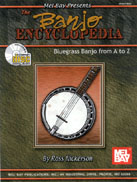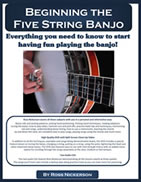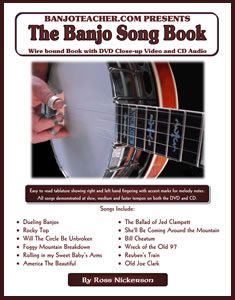by Ross Nickerson
“How do I become a, good banjo player?” I’m sure for anyone that is learning or thinking of taking up the banjo they will have this question, I’ve written out 10 steps to success with suggestions that I feel will guide you in a focused direction with a clearer understanding of the task at hand. Each one of my 10 steps I also lend further insight and banjo instruction to help you prioritize your practice time. I’ve gained a lot of experience working with banjo students having now taught banjo for 40 years privately along with group classes at banjo camps and workshops. One thing I know for sure is that many of the difficulties and obstacles banjo students face are the same for no matter who they are, where they live, or what language they speak. So, with that in mind, here are 10 steps for success to become a good banjo player and where to focus your practice time.
- Practice Timing and Be a Steady Picker: One of the 10 steps of how to become a good banjo player is to approach the banjo as a rhythm instrument much like a drummer would. Your primary responsibility as a banjo player is to produce a steady rhythm and play in time. That comes first, and then you can concern yourself with the melody and other nuances of banjo playing. Following banjo tablature numbers around on a page with no regard to the timing of 1/4 and 1/8 notes is not the way you learn to play banjo.
- Learn to Play Without Tablature: You “learn to play banjo” without tablature. However, you can learn songs or techniques very quickly from tablature. So, what this means is, you use tablature to get the information needed, but you develop the skills needed to play a song without looking at tablature. I recorded a DVD that could really help those who want to play without tab and understand how it’s done. It covers the many things that are hard to learn from books, from practicing at home or even taking private lessons. It’s the Forest through the Trees and if you are presently learning from tab, don’t throw the tab away, save it for later, but get this DVD.Playing Banjo By Ear and Learning the Chords
- Learn Skills that apply to many songs so you can learn songs quicker and play them better: Learn and use skill practice exercises and drills that are challenging. By practicing things that are more difficult than the skills needed to play the songs you want to learn, it will help you relax and execute. Keep raising the bar on yourself when you practice. How to Practice Banjo
- Learn to Play Banjo in Different Keys: Even if you play only at home and even if playing in a different key is simply putting a capo on. Do that, playing with a capo gives you a whole new fun sound. For those of you just learning banjo it makes pull-offs, hammer-ons and slides easier to learn and do. If you do play with others, you will need some experience with a capo ahead of time. If you are way past that, get good at playing in the key of D in open G tuning. The techniques you learn to play in the key of D can be transposed to the key of C, E, F and G Up the Neck. I get into a lot of detail about that on my DVD
Playing in the Keys of C, D, E, F and G Up the Neck - Play in tune and learn how to tune quietly, fast and after you put a capo on: Practicing these tuning skills at home is wise and a super valuable skill. Because banjo players use a capo often and the banjo can easily get thrown out of tune when you add a capo, banjo players often are the last to get in tune, and need to tune more. Because a guitar with a capo normally requires less re-tuning and mandolins and fiddles do not use a capo, banjo players are often teased about tuning. Don’t be that guy at the jam, practice tuning at home. Speaking as a banjo player it can be an unfair knock because a movable wood bridge on a drum head is simply not as stable a design as a guitar. Because banjo tuning is tricky give it the extra attention it deserves so you don’t attract the wrong kind of attention while tuning.
- Practice your Fretting hand skill: This helps you relax and play in tune because left hand pressure has a lot to do with how in tune you sound and the tone you get. This is the most neglected area of practice for banjo players and it does matter, a lot. Picking must just be too much fun for everyone because many banjo players treat fretting hand skills like they don’t need matter and rarely practice them.
- Practice and Learn Good Banjo Technique: – Without it you have nothing to build on. Backing up in the learning process to improve or perfect technique is smart and a NORMAL part of the process. We all do it or have done it. I wrote a book called The Banjo Encyclopedia “Bluegrass Banjo from A to Z” which is essentially a banjo technique book. It’s 240 pages of exercises and songs used to teach the important 3 finger bluegrass Scruggs’, Single String and Melodic Style banjo techniques.
- Learn how chord progression’s work: When you play with others, in bands or in jams, the chords to the song are all you get. If you learn to play through a song and improvise a solo based on the chord progression you can play most any song with anyone. I have a jamming practice DVD that features 7 important standards you may already know or want to learn that you can play along with. I included the chords to each song and first show you how to pick through the chord progression. The DVD also includes tab for the songs and a bonus lessons to learn all the major minor and seventh chord chords without a book. Banjo Jamming and Play Along
- Learn the most important Scruggs Style Techniques: If you want to learn good technique, especially in the picking and tone, study Earl Scruggs. For years I recorded Earl Scruggs songs on a variety of recording devices for private lesson students so they could hear it slowed down and up to speed. In 1990 I made a studio recording of Earl Scruggs Songs slowed down and up to tempo and on the recording walked through the tab for each song demonstrating sections slowed down. It’s called Scruggs Style Instruction for Five String Banjo and it is a great way to learn proper Earls Scruggs Style technique.
Hear a sound clip of the faster versions for two of the songs included the Book and CDs.
Foggy Mountain Breakdown
Ground Speed - Don’t overplay by cramming too many licks in, or play too loud: Learn to Play your banjo softer but still with good attack. If you can record yourself playing and listen back you will realize as I have in the studio many times that some of the best sounding banjo you can play are things you learned at the very beginning.




